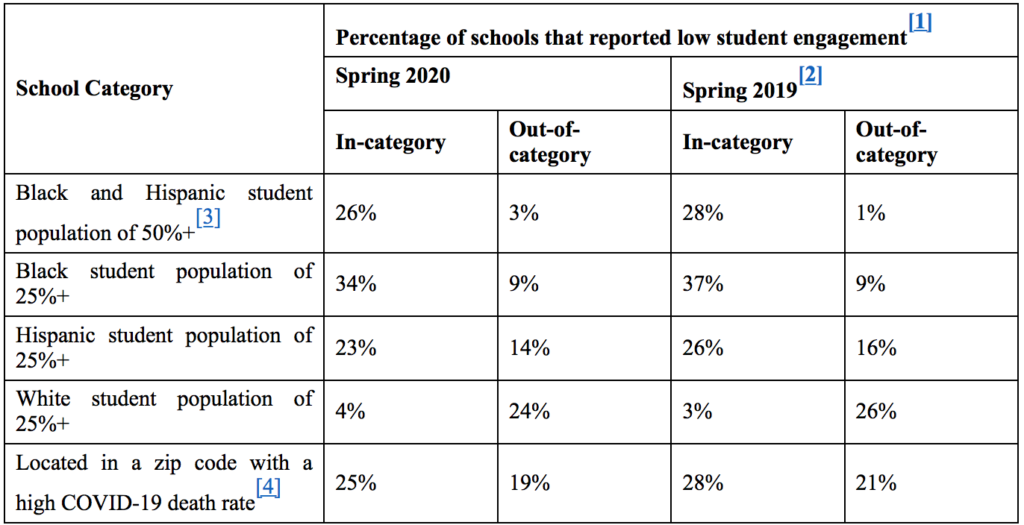Council subpoenaed the Education Department to obtain the data
New York City Council Speaker Corey Johnson and Education Committee Chair Mark Treyger announced key findings based on remote learning attendance data from the city Education Department (DOE), which was received in response to a subpoena issued by the New York City Council last month. That data on more than 1,500 schools shows racial disparities in student engagement – loosely defined as attendance that was tracked by student emails or participation in remote check-ins – during the COVID-19 pandemic.
Highlights from the remote learning attendance data include:
- Schools where at least half the student population was Black and Hispanic were nearly eight times more likely to report low student engagement or poor attendance compared to schools with lower Black and Hispanic populations.
- Schools where 25% or more of the students were Black were nearly four times more likely to report low student engagement than schools with fewer Black students
- Schools where 25% of more of the population was white showed high student engagement.
- These racial disparities data mirror attendance data from 2019, highlighting that these inequities continued during our pandemic.
“By forcing the Education Department to release attendance data on the pandemic, the City Council was able to confirm what many feared – that there were racial disparities in student engagement during remote learning. But we are still not seeing the full scope of the inequities that exist in remote learning because we don’t have specifics on what type of instruction these students received. The school system’s policy is to say a student attended even if all they did was send a text or email. The de Blasio Administration needs to provide us with more clarity and understanding of remote learning during COVID-19 so we can properly address the disparities and provide the support New York City’s students need. I thank Education Committee Chair Treyger for his leadership on this issue and for always being our students’ biggest advocate,” said Speaker Corey Johnson.
“The City administration cannot dismiss the significance of this concerning attendance data. It further paints a picture of a city perpetuating the divide between well-resourced and under-resourced communities. At the May hearing on remote learning, I asked how many kids never logged onto a device. I asked for school by school attendance data because as a former teacher, I understand how attendance is a major indicator of student progress and school climate. We need this information to know how to target and fight for additional support for kids who need it the most,” said Council Member Mark Treyger, Chair of the Committee on Education.
The data was originally requested in May by Education Chair Treyger at an oversight hearing titled, “Remote Learning: The Impact of Coronavirus (COVID-19) on the City’s Schools.” The daily remote learning attendance data provided by the Education Department is from April 6 – June 26 for the Spring 2020 semester, July 6 to August 14 for the Summer 2020 semester, and September 16 and 17 for the Fall semester.
New York City schools shut down on March 16, 2020. Schools transitioned to remote learning a week later but after six months there are still unresolved issues that are preventing students from receiving a high-quality remote education, such as access to the internet and mandated special education services.
Remote learning attendance data is critical, but it doesn’t tell us if the student is really interacting with the teacher. On Friday, during an oversight hearing on school reopening by Council Committees on Education and Health, the Council will review two bills designed to obtain better metrics.
The hearing will review Intro 2104-2020 (Treyger) which would require the Education Department to report on a series of metrics any time the department is engaged in remote learning such as participation in synchronous and/or asynchronous remote learning instruction, IEP evaluations completed as well as mandated services provided to students with disabilities, among other metrics. The first report would be due on August 1, 2021, for the 2020-2021 academic year, and the 2019-2020 academic year report would be due on February 1, 2021.
The second bill, Intro 2058-2020 (Public Advocate Jumaane Williams and Treyger), would require the Education Department to provide weekly mandated reports on student attendance data when remote learning is utilized fully or combined with in-person learning. The data would be required to be disaggregated by the school, school district, grade, race, individualized education plan status, multilingual language learner status and English language learner status.
You can access the DOE’s full data set on remote learning attendance here.

[1] For the purposes of this table, a school encountered a significant barrier to student interaction if its median daily student interaction rate for the period was low enough to put it in the bottom 20% of all schools. For Spring 2020, this means an interaction rate below about 79%, and for Spring 2019, it means a rate below about 89%.
[1] DOE’s attendance data for Spring 2019 can be found on the NYC Open Data Portal athttps://data.cityofnewyork.us/Education/2018-2019-Daily-Attendance/x3bb-kg5j.
[1] Student populations were estimated using Fall 2020 enrollment data provided in DOE’s subpoena response materials.
[1] COVID-19 data for each zip code is maintained by the NYC Department of Health and Mental Hygiene and can be found online at https://github.com/nychealth/coronavirus-data. A “high” COVID-19 death rate means a death rate that would put the zip code in the top 20% of all zip codes.
No comments:
Post a Comment